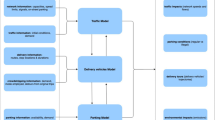Abstract
Most current crowdsourced logistics aim to minimize systems cost and maximize delivery capacity, but the efforts of crowdsourcers such as drivers are almost ignored. In the delivery process, drivers usually need to take long-distance detours in hitchhiking rides based package deliveries. In this paper, we propose an approach that integrates offline trajectory data mining and online route-and-schedule optimization in the hitchhiking ride scenario to find optimal delivery routes for packages and drivers. Specifically, we propose a two-phase framework for the delivery route planning and scheduling. In the first phase, the historical trajectory data are mined offline to build the package transport network. In the second phase, we model the delivery route planning and package-taxi matching as an integer linear programming problem and solve it with the Gurobi optimizer. After that, taxis are scheduled to deliver packages with optimal delivery paths via a newly designed scheduling strategy. We evaluate our approach with the real-world datasets; the results show that our proposed approach can complete citywide package deliveries with a high success rate and low extra efforts of taxi drivers.
Similar content being viewed by others
References
Agatz N, Fleischmann M, Van Nunen J. E-fulfillment and multichannel distribution—a review. European Journal of Operational Research, 2008, 187(2): 339–356
Ogawara S, Chen J, Zhang Q. Internet grocery business in Japan: current business models and future trends. Industrial Management & Data Systems, 2003, 103(9): 727–735
Chen C, Zhang D, Ma X, Guo B, Wang L, Wang Y, Sha E. Crowddeliver: planning city-wide package delivery paths leveraging the crowd of taxis. IEEE Transactions on Intelligent Transportation Systems, 2016, 18(6): 1478–1496
Fatnassi E, Chaouachi J, Klibi W. Planning and operating a shared goods and passengers on-demand rapid transit system for sustainable city-logistics. Transportation Research Part B: Methodological, 2015, 81: 440–460
Chen Y, Guo D, Xu M, Tang G, Zhou T, Ren B. PPtaxi: non-stop package delivery via multi-hop ridesharing. IEEE Transactions on Mobile Computing, 2019, 19(11): 2684–2698
Chen C, Yang S, Wang Y, Guo B, Zhang D. CrowdExpress: a probabilistic framework for on-time crowdsourced package deliveries. IEEE Transactions on Big Data, 2020, DOI: https://doi.org/10.1109/TBDATA.2020.2991152
Lindholm M, Behrends S. Challenges in urban freight transport planning-a review in the Baltic Sea Region. Journal of Transport Geography, 2012, 22: 129–136
Lerner W, Audenhove V. The future of urban mobility: towards networked, multimodal cities in 2050. Public Transport International, 2012
Chen W, Mes M, Schutten M. Multi-hop driver-parcel matching problem with time windows. Flexible Services and Manufacturing Journal, 2018, 30(3): 517–553
Cohen B, Munoz P. Sharing cities and sustainable consumption and production: towards an integrated framework. Journal of Cleaner Production, 2016, 134: 87–97
Punel A, Ermagun A, Stathopoulos A. Studying determinants of crowd-shipping use. Travel Behaviour and Society, 2018, 12: 30–40
Paloheimo H, Lettenmeier M, Waris H. Transport reduction by crowdsourced deliveries—a library case in Finland. Journal of Cleaner Production, 2016, 132: 240–251
Kafle N, Zou B, Lin J. Design and modeling of a crowdsource-enabled system for urban parcel relay and delivery. Transportation Research Part B: Methodological, 2017, 99: 62–82
Archetti C, Savelsbergh M, Speranza M. The vehicle routing problem with occasional drivers. European Journal of Operational Research, 2016, 254(2): 472–480
Arslan A, Agatz N, Kroon L, Zuidwijk R. Crowdsourced delivery—a dynamic pickup and delivery problem with ad hoc drivers. Transportation Science, 2019, 53(1): 222–235
Deng W, Guan X, Ma S, Liu S. Selection of crowdsourcing formats: simultaneous contest vs sequential contest. Industrial Management & Data Systems, 2019, 119(1): 35–53
Le T, Stathopoulos A, Van Woensel T, Ukkusuri S. Supply, demand, operations, and management of crowd-shipping services: a review and empirical evidence. Transportation Research Part C: Emerging Technologies, 2019, 103: 83–103
Ermagun A, Shamshiripour A, Stathopoulos A. Performance analysis of crowd-shipping in urban and suburban areas. Transportation, 2019, 47: 1955–1985
Pavlidou I, Papagiannidis S, Tsui E. Crowdsourcing: a systematic review of the literature using text mining. Industrial Management & Data Systems, 2020, 120(11): 2041–2065
Chen Y, Guo D, Xu M, Tang G, Cheng G. Measuring maximum urban capacity of taxi-based logistics. IEEE Transactions on Intelligent Transportation Systems, 2021, 22(10): 6449–6459
Barr A, Wohl J. Exclusive: walmart may get customers to deliver packages to online buyers. Reuters-business Week, 2013
Bensinger G. Amazon’s next delivery drone: you. Wall Street Journal, 2015, 265(140): B1–B2
Li B, Krushinsky D, Reijers H, Van Woensel T. The share-a-ride problem: people and parcels sharing taxis. European Journal of Operational Research, 2014, 238(1): 31–40
Li B, Krushinsky D, Van Woensel T, Reijers H. The share-a-ride problem with stochastic travel times and stochastic delivery locations. Transportation Research Part C: Emerging Technologies, 2016, 67: 95–108
Lim M, Wang J, Wang C, Tseng M. A novel method for green delivery mode considering shared vehicles in the IoT environment. Industrial Management & Data Systems, 2020, 120(9): 1733–1757
Macrina G, Pugliese L, Guerriero F, Laporte G. Crowd-shipping with time windows and transshipment nodes. Computers & Operations Research, 2020, 113: 104806
Ghilas V, Demir E, Van Woensel T. Integrating passenger and freight transportation: model formulation and insights. In: Proceedings of the 2013 Beta Working Papers; Technische Universiteit Eindhoven: Eindhoven, The Netherlands. 2013, 1–23
Masson R, Trentini A, Lehuédé F, Malhéné N, Péton O, Tlahig H. Optimization of a city logistics transportation system with mixed passengers and goods. EURO Journal on Transportation and Logistics, 2017, 6(1): 81–109
Chen C, Pan S, Wang Z, Zhong R. Using taxis to collect citywide Ecommerce reverse flows: a crowdsourcing solution. International Journal of Production Research, 2017, 55(7): 1833–1844
Cleophas C, Cottrill C, Ehmke J, Tierney K. Collaborative urban transportation: recent advances in theory and practice. European Journal of Operational Research, 2019, 273(3): 801–816
Chen C, Chen X, Wang Z, Wang Y, Zhang D. ScenicPlanner: planning scenic travel routes leveraging heterogeneous user-generated digital footprints. Frontiers of Computer Science, 2017, 11(1): 61–74
Guo S, Chen C, Wang J, Liu Y, Ke X, Yu Z, Zhang D, Chiu D. Rodrevenue: seeking strategies analysis and revenue prediction in ride-ondemand service using multi-source urban data. IEEE Transactions on Mobile Computing, 2019, 19(9): 2202–2220
Chen C, Ding Y, Wang Z, Zhao J, Guo B, Zhang D. VTracer: when online vehicle trajectory compression meets mobile edge computing. IEEE Systems Journal, 2019, 14(2): 1635–1646
Pan S, Giannikas V, Han Y, Grover-Silva E, Qiao B. Using customerrelated data to enhance e-grocery home delivery. Industrial Management & Data Systems, 2017, 117(9): 1917–1933
Wang J, Wang X, Li C, Wu J. Deep fuzzy cognitive maps for Interpretable multivariate time series prediction. IEEE Transactions on Fuzzy Systems, 2020, 29(9): 2647–2660
Wang J, Wu J, Wang Z, Gao F, Xiong Z. Understanding urban dynamics via context-aware tensor factorization with neighboring regularization. IEEE Transactions on Knowledge and Data Engineering, 2019, 32(11): 2269–2283
Wang J, Wu N, Lu X, Zhao X, Feng K. Deep trajectory recovery with fine-grained calibration using kalman filter. IEEE Transactions on Knowledge and Data Engineering, 2019, 33(3): 921–934
Chai D, Wang L, Chen K, Yang Q. Secure federated matrix factorization. IEEE Intelligent Systems, 2020, 36(5): 11–20
Skiena S. Combinatorics and graph theory with mathematica. 2003
Tarjan R. Depth-first search and linear graph algorithms. Siam Journal on Computing, 1972, 1(2): 146–160
Dötterl J, Bruns R, Dunkel J, Ossowski S. On-time delivery in crowdshipping systems: an agent-based approach using streaming data. In: Frontiers in Artificial Intelligence and Applications. IOS Press, 2020, 51–58
Balasubramanian A, Levine B, Venkataramani A. DTN routing as a resource allocation problem. ACM Sigcomm Computer Communication Review, 2007, 37(4): 373–384
Ko Y, Vaidya N. Flooding-based geocasting protocols for mobile ad hoc networks. Mobile Networks and Applications, 2002, 7(6): 471–480
Zhang L, Yu B, Pan J. GeoMob: a mobility-aware geocast scheme in metropolitans via taxicabs and buses. In: Proceedings of IEEE INFOCOM 2014-IEEE Conference on Computer Communications. 2014, 1279–1787
Zorzi M, Rao R. Geographic random forwarding (GeRaF) for ad hoc and sensor networks: energy and latency performance. IEEE Transactions on Mobile Computing, 2003, 2(4): 349–365
Acknowledgements
This work was supported in part by the National Natural Science Foundation of China (Grant No. 61872050), in part by the Chongqing Basic and Frontier Research Program (cstc2018jcyjAX0551), Foundation of Chongqing Municipal Key Laboratory of Institutions of Higher Education ([2017]3), Foundation of Chongqing Development and Reform Commission (2017[1007]), and Foundation of Chongqing Three Gorges University. Sijing Cheng and Chao Chen contributed equally to this work. Wei Zhang is the corresponding authors for this paper.
Author information
Authors and Affiliations
Corresponding author
Additional information
Sijing Cheng is pursuing his master degree at the College of Computer Science, Chongqing University, China. He received the BSc degree from the College of River and Ocean Engineering, Chongqing Jiaotong University, China in 2017. His research interests include taxi GPS trajectory data mining and last-mile delivery.
Chao Chen is a Full Professor at College of Computer Science, Chongqing University, China. He obtained his PhD degree from Pierre and Marie Curie University and TELECOM SudParis, France in 2014. He received the BSc and MSc degrees in control science and control engineering from Northwestern Polytechnical University, China in 2007 and 2010, respectively. Dr. Chen got published over 100 papers including 20 IEEE Transactions. His work on taxi trajectory data mining was featured by IEEE Spectrum three times, in 2011, 2016 and 2020, respectively. He was also the recipient of the Best Paper Runner-Up Award at MobiQuitous 2011. His research interests include pervasive computing, mobile computing, urban logistics, data mining from large-scale GPS trajectory data, and big data analytics for smart cities.
Shenle Pan is associate professor of sustainable logistics and supply chain management and co-director of the Physical Internet Chair at MINES ParisTech-PSL University in France. He received his Habilitation (HDR) degree from Université Polytechnique Hauts-de-France, PhD degree from MINES ParisTech, Engineer’s degree from Arts et Métiers ParisTech, France. Since 2010, he has been PI or co-PI for 15 research projects (H2020, FP7, ANR, etc.), published more than 60 papers in peer reviewed journals and conferences, and served as guest editor for four special issues on top academic journals. His research interests include Physical Internet, sustainability, smart logistics, freight transportation, inventory management, operations research and applications in logistics and supply chain.
Hongyu Huang (Member, IEEE) received the BS degree from Chongqing Normal University, China in 2002, the MS degree from Chongqing University, China in 2005, and the PhD degree from Shanghai Jiao Tong University, China in 2009. He is currently an Associate Professor with the College of Computer Science, Chongqing University, China. His research interests include mobile crowd-sensing, privacy preserving computing, and vehicular ad hoc networks.
Wei Zhang received the BS degree in computer engineering and application from Chongqing University, China in 1992, and the MS degree in computer engineering and application from Southwest University, China in 1999, and the PhD degree in computer software and theory from Chongqing University, China in 2003. In 2007, he was a Postdoctoral Research Fellow of control science and engineering with Chongqing University, China. He mainly engages in computational intelligence, information security, and data mining.
Yuming Feng received the BS and MS degrees in mathematics from Yunnan University, China in 2003 and 2006, respectively, and the PhD degree in applied mathematics from Southwest University, China in December 2016. From January 2012 to October 2012, he served as a Research Scholar with Udine University, Italy. From December 2014 to April 2015, he served as a Research Scholar with Texas A&M University at Qatar, Qatar. Since December 2018, he has been a Professor with Chongqing Three Gorges University, China. His current research interests include distributed optimization theory, neural networks, chaos control and synchronization, fuzzy algebra, and hyperalgebra.
Electronic Supplementary Material
Rights and permissions
About this article
Cite this article
Cheng, S., Chen, C., Pan, S. et al. Citywide package deliveries via crowdshipping: minimizing the efforts from crowdsourcers. Front. Comput. Sci. 16, 165327 (2022). https://doi.org/10.1007/s11704-021-0568-5
Received:
Accepted:
Published:
DOI: https://doi.org/10.1007/s11704-021-0568-5




